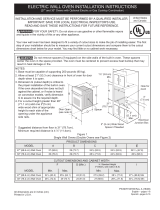
13
INSTRUCCIONES DE INSTALACIÓN PARA EL HORNO ELÉCTRICO DE PARED
(con instrucciones para la instalación de la combinación lado a lado y de la estufa)
Notas importantes para el instalador
1. Lea todas las instrucciones contenidas en este
manual antes de instalar el horno.
2. Saque todo el material usado en el embalaje del
compartimiento del horno antes de conectar el
suministro eléctrico o de gas a la estufa.
3. Observe todos los códigos y reglamentos pertinentes.
4. Deje estas instrucciones con el consumidor.
5. Retire la puerta del horno para facilitar la instalación.
Consulte la guía de uso y cuidado para obtener
instrucciones.
6. ESTE HORNO NO ESTÁ APROBADO PARA LA
INSTALACIÓN APILABLE O DE LADO A LADO.
Nota importante al consumidor
Conserve estas instrucciones y el manual del usuario para
uso del inspector local de electricidad y referencia futura.
INSTRUCCIONES IMPORTANTES DE
SEGURIDAD
• Asegúrese de que su horno de pared sea instalado y
puesto a tierra de forma apropiada por un instalador
calicado o por un técnico de servicio.
• Este horno de pared debe ser eléctricamente puesto
a tierra de acuerdo con los códigos locales o, en su
ausencia, con el Código Eléctrico Nacional ANSI/
NFPA No. 70–última edición en los Estados Unidos,
o el Código Eléctrico Canadiense CSA Standard
C22.1, Part 1, en Canadá.
Pisar, apoyarse, o sentarse sobre la
puerta de este horno de pared puede causar serias
lesiones y daños al horno de pared.
Nunca use su horno de pared para
calentar una habitación. El uso prolongado de la estufa
sin la ventilación adecuada puede ser peligroso.
La corriente eléctrica al horno debe
estar apagada mientras se hacen las conexiones
de líneas. Si no se apaga, daños serios o la muerte
podrían resultar.
1. Carpintería
Consulte la Figura 1 o la gura 2 para conocer las
dimensiones pertinentes al modelo de su horno y
al espacio necesario en el que poner el horno. La
supercie donde se va a apoyar el horno debe de ser de
madera contrachapada sólida u otro material similar y,
sobre todo, la supercie tiene que estar a nivel, de lado
a lado, y de atrás hacia adelante.
2. Ajuste de la altura del horno
La altura del horno se puede ajustar con cuñas de
madera de 2" (5 cm) de ancho, donde sea necesario,
para que quepa en un gabinete o abertura existente,
cuando la altura del corte es superior a 28
1
/
4
" (71.8 cm)
en el caso del horno único de pared o 49
5
/
8
" (126 cm)
en el caso del horno doble de pared (ver la Figura 1 o
2). Colocar las cuñas de altura apropiada debajo de los
rieles laterales del horno.
3. Requerimientos Eléctricos
Se debe proveer el voltaje y la frecuencia apropiados a
este electrodoméstico, y conectarse a un circuito individual
correctamente puesto a tierra, protegido por un interruptor
o un fusible. Para conocer el interruptor o fusible que
requiere su modelo, vea la placa serial para encontrar
la consumación del vatiaje y reérase al cuadro A para
encontrar el amperaje del interruptor o fusible.
Table A
Observe todos los códigos que gobiernan y ordenanzas
locales
1. Un cable de 3 o 4 alambres monofásico 120/240 o
120/208 voltios, 60 hertzios es la única fuente eléctrica
que requiere en un circuito separado en ambos lados de
la línea (alambre negro y alambre rojo) (se recomienda
un fusible o un interruptor de retraso de tiempo). No
funda a cable neutro (alambre blanco). Se debe de
tener precaución al combinar un horno de pared y una
cubierta, reérase a la placa de seria de cada uno de
los aparatos. No instale una estufa sobre una instalación
de horno de pared de lado a lado.
NOTA: Los tamaños y las conexiones del alambre deben
conformarse con el tamaño del fusible y el grado de la
aplicación de acuerdo con el código Eléctrico Nacional
Americano ANSI/NFPA No. 70- ultima edición, o con
el estándar CSA canadiense C22.1, código eléctrico
canadiense, parte 1, y códigos y ordenanzas locales.
No se debera usar extensiones para
enchufar este electrodoméstico. Esto podría causar
un incendio, choque eléctrico u otro tipo de daño
personal. Si usted necesita un cable mas largo, puede
ordenar un cable de 10" kit 903056-9010 llamando al
centro de Servicio.
2. Este electrodoméstico debe conectarse a la caja
de fusibles (o de cortocircuito), por medio de un
cable blindado exible o un cable con forro no
metálico. El cable blindado exible que va desde
el electrodoméstico debe de estar conectado
directamente a la caja de empalme. La caja de
empalme debe de estar localizada en el lugar
que se indica en la Figura 1 o 2, dejando tanto
exceso de cable como sea posible entre la
caja y el electrodoméstico, de forma que así el
electrodoméstico se pueda mover fácilmente, si fuera
necesario para hacer una reparación.
3. Se debe de usar un conector que reduzca la tirantez
de una forma adecuada para unir el cable blindado
exible a la caja de empalme.
Grados de
Vatios del
lectrodoméstico
240V
Se
recomienda
una
protección al
circuito
Grados de
Vatios del
lectrodoméstico
208V
Se
recomienda
una
protección al
circuito
Menos de
4800W
20A
Menos de 4100W
20A
4801W - 7200W
30A
4101W - 6200W
30A
7201W - 9600W
40A o 50A
6201W - 8300W
40A o 50A
9601W and +
50A
8301W and +
50A





















